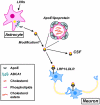Apolipoprotein E and its receptors in Alzheimer's disease: pathways, pathogenesis and therapy
- PMID: 19339974
- PMCID: PMC2908393
- DOI: 10.1038/nrn2620
Apolipoprotein E and its receptors in Alzheimer's disease: pathways, pathogenesis and therapy
Abstract
The vast majority of Alzheimer's disease (AD) cases are late-onset and their development is probably influenced by both genetic and environmental risk factors. A strong genetic risk factor for late-onset AD is the presence of the epsilon4 allele of the apolipoprotein E (APOE) gene, which encodes a protein with crucial roles in cholesterol metabolism. There is mounting evidence that APOE4 contributes to AD pathogenesis by modulating the metabolism and aggregation of amyloid-beta peptide and by directly regulating brain lipid metabolism and synaptic functions through APOE receptors. Emerging knowledge of the contribution of APOE to the pathophysiology of AD presents new opportunities for AD therapy.
Figures






References
-
- Blennow K, de Leon MJ, Zetterberg H. Alzheimer’s disease. Lancet. 2006;368:387–403. - PubMed
-
- Hardy J, Selkoe DJ. The amyloid hypothesis of Alzheimer’s disease: progress and problems on the road to therapeutics. Science. 2002;297:353–356. - PubMed
-
- Selkoe D, Kopan R. Notch and Presenilin: regulated intramembrane proteolysis links development and degeneration. Annu. Rev. Neurosci. 2003;26:565–597. - PubMed
Publication types
MeSH terms
Substances
Grants and funding
LinkOut - more resources
Full Text Sources
Other Literature Sources
Medical
Miscellaneous

